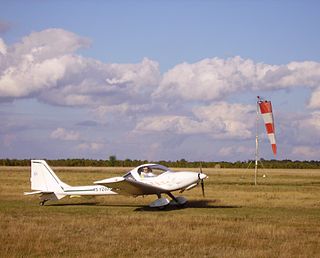
The RA-14 Loisirs was a French two-seat high-wing light touring aircraft designed by Roger Adam shortly after World War II.
The Comp Air 4 is an American light civil utility aircraft manufactured in kit form by Comp Air. Builders are able to choose between an airframe designed for engines in the 140-180 hp (104-134 kW) range, and a heavier one for 250 hp (187 kW) units. The latter airframe can be fitted with up to six seats, while the standard airframe seats four. The Comp Air 4 may be built with tailwheel, tricycle, float, or amphibious float undercarriage.

The SAI KZ III Lærke ("lark") was a Danish light utility aircraft used by the Danish Air Ambulance Service and Danish Air Force.

The ICA IS-29 was a sailplane built in Romania in the 1970s. The prefix IS comes from Iosif Șilimon, the Romanian IAR aeronautical engineer who designed it.

The Agusta AZ.8L, or Agusta-Zappata AZ.8L, was an Italian airliner prototype first flown on 9 June 1958. It was of conventional low-wing monoplane configuration with tricycle undercarriage and all-metal construction. Filippo Zappata's design grew out of a twin-engined transport designated AZ.1 that was never built.

The Air Tractor AT-400 is a family of agricultural aircraft that first flew in the United States on September 1979. Type certification was awarded to Air Tractor in April 1980. Of low-wing monoplane taildragger configuration, they carry a chemical hopper between the engine firewall and the cockpit.

The Cessna Model 411 is an American twin-engined, propeller-driven, pressurized light aircraft built by Cessna Aircraft. It was that company's largest business aircraft to enter production when it first flew in 1962.
The Auster Avis was a four-seat light aircraft developed from the Auster Autocrat. It featured a redesigned fuselage incorporating four doors and a circular cross-section towards the tail, new undercarriage, and new wing flaps. It was planned in two versions, the Mk 1 for civil use, and the Mk 2 for military and air ambulance duties. However, only two prototypes were built, and Auster abandoned the project in favour of the Auster J-5 Autocar.
The Brochet MB.120 was a two-seat light aircraft developed in France in the 1950s.

The SAI KZ VII Lærke was a light utility aircraft built in Denmark shortly after the Second World War. Based on the SAI KZ III air ambulance, the KZ VII was a strut-braced, high-wing monoplane of conventional design with an enclosed cabin for four seats. Fifty-six aircraft were built, and another 22 partially completed aircraft were destroyed in a factory fire in 1947. The Danish Air Force operated 10 of the type as trainers between 1950 and 1977.

The Wassmer WA-80 Piranha is a French two-seat low-wing cabin monoplane trainer designed and built by Société Wassmer. Based on the same construction as the company's WA-50 four-seater, the WA-80 was a scaled down version. The prototype, registered F-WVKR, first flew in November 1975 powered by a 100 hp Rolls-Royce Continental O-200 engine. Wassmer appointed a receiver and suspended production in 1977 after 25 had been built.

The NAC-1 Freelance, originally the BN-3 Nymph, is a British four-seat touring monoplane.

The Promavia F.1300 Jet Squalus, also known as Promavia Jet Squalus F1300, was a two-seat light jet trainer designed by Italian Stelio Frati and built by Promavia in Belgium with support from the Belgian government.

The Valentin Taifun is a two-seat self-launching sailplane designed and built by Valentin Flugzeugbau GmbH of Hasfurt, Germany.

The Varga 2150 Kachina is an American all-metal, low-wing, fixed-gear, two-seat light aircraft fitted with a tricycle undercarriage.

The ASK 16 was designed by Rudolf Kaiser for production by Alexander Schleicher GmbH & Co of Furth, Germany. The aircraft is of welded tube, wood and fabric construction and has a low-set high-aspect-ratio wing.
The Partenavia P.70 Alpha was a 1970s Italian two-seat light aerobatic trainer designed by Luigi Pascale and built by Partenavia.

The CFM Shadow is a British Microlight or Group A aircraft designed in the 1980s by David Cook who went on to run ‘Cook Flying Machines’ - where the aircraft was manufactured as a choice of a BMAA fully built machine or an LAA home build kit. It is of high wing, pusher, pod and boom layout and seats two. Around 400 have been built.
The Tisserand Hydroplum is a small amphibious aircraft with a single, pusher engine, built in France in the 1980s. Originally a single-seat, high-wing monoplane, it was developed into a two-seat biplane for production in kit form as the SMAN Pétrel.

The Aviakit Véga is an ultralight aircraft seating two in side-by-side configuration. It was designed in France in the late 1990s to be easily constructed by amateurs from kits and was offered with a choice of three engines and of tricycle or conventional undercarriages.















